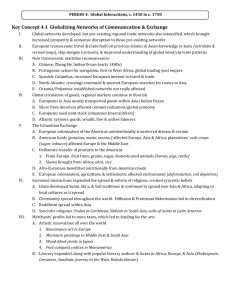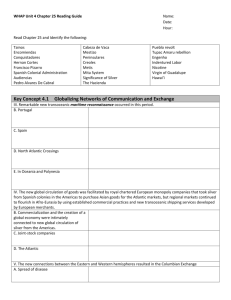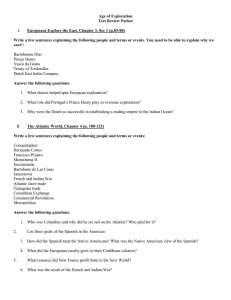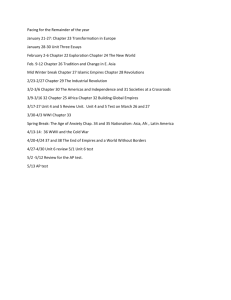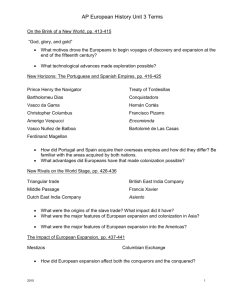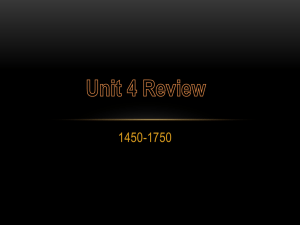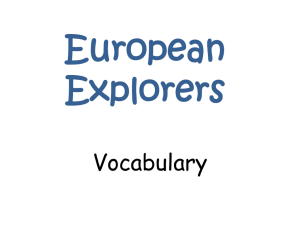Key Concepts - Condensed Era #4
advertisement
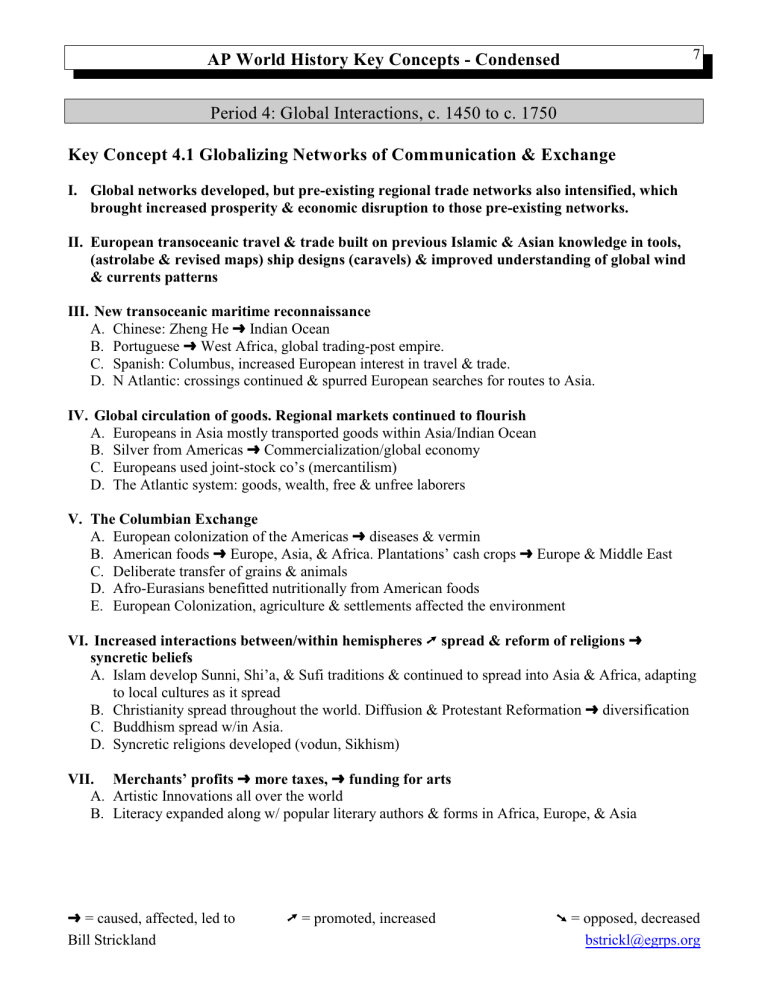
AP World History Key Concepts - Condensed 7 Period 4: Global Interactions, c. 1450 to c. 1750 Key Concept 4.1 Globalizing Networks of Communication & Exchange I. Global networks developed, but pre-existing regional trade networks also intensified, which brought increased prosperity & economic disruption to those pre-existing networks. II. European transoceanic travel & trade built on previous Islamic & Asian knowledge in tools, (astrolabe & revised maps) ship designs (caravels) & improved understanding of global wind & currents patterns III. New transoceanic maritime reconnaissance A. Chinese: Zheng He º Indian Ocean B. Portuguese º West Africa, global trading-post empire. C. Spanish: Columbus, increased European interest in travel & trade. D. N Atlantic: crossings continued & spurred European searches for routes to Asia. IV. Global circulation of goods. Regional markets continued to flourish A. Europeans in Asia mostly transported goods within Asia/Indian Ocean B. Silver from Americas º Commercialization/global economy C. Europeans used joint-stock co’s (mercantilism) D. The Atlantic system: goods, wealth, free & unfree laborers V. The Columbian Exchange A. European colonization of the Americas º diseases & vermin B. American foods º Europe, Asia, & Africa. Plantations’ cash crops º Europe & Middle East C. Deliberate transfer of grains & animals D. Afro-Eurasians benefitted nutritionally from American foods E. European Colonization, agriculture & settlements affected the environment VI. Increased interactions between/within hemispheres ü spread & reform of religions º syncretic beliefs A. Islam develop Sunni, Shi’a, & Sufi traditions & continued to spread into Asia & Africa, adapting to local cultures as it spread B. Christianity spread throughout the world. Diffusion & Protestant Reformation º diversification C. Buddhism spread w/in Asia. D. Syncretic religions developed (vodun, Sikhism) VII. Merchants’ profits º more taxes, º funding for arts A. Artistic Innovations all over the world B. Literacy expanded along w/ popular literary authors & forms in Africa, Europe, & Asia º = caused, affected, led to Bill Strickland ü = promoted, increased ú = opposed, decreased bstrickl@egrps.org 8 AP World History Key Concepts - Condensed Key Concept 4.2 New Forms of Social Organization & Modes of Production I. Traditional peasant agriculture & plantations ü, labor demand ü, both feeding & responding to ü global demand for raw materials & finished products. A. Peasant labor intensified (e.g. Russian Siberia, Indian cotton Chinese silk) B. Slavery in Africa 1. slaves into households continued 2. export to Mediterranean & Indian Ocean expanded C. Atlantic slave trade üdemand D. Coerced labor (encomienda, hacienda, slavery, indent serv, mit’a) ü American plantation economy II. As new social/political elites changed, they restructured new ethnic/racial/gender hierarchies. A. Imperial conquests & economic opportunities ü new pol & econ elites B. Existing pol & econ elites fluctuated as they confronted new challenges C. Gender/family restructuring 1. African slave trades 2. dependence of European men on women for trade in SE Asia 3. smaller size of European families D. American demographic changes º new ethnic & racial classifications Key Concept 4.3 State Consolidation & Imperial Expansion I. Methods used to legitimize & consolidate rulers’ power. A. Visual displays B. Religious ideas C. States used ethnic/religious groups to contribute economically, but limited their political challenge. D. States recruited/used bureaucratic elites & military professionals ü central control E. Tribute collection & tax farming º territorial expansion. II. Gunpowder, cannons & armed trade º large empires A. Europeans trading post empires in Africa & Asia 1. profit for rulers & merchants 2. affected power of states in interior W & C Africa. B. Land empires grew dramatically in size C. New European maritime empires in the Americas. III. Challenges to states A. Competition over trade routes B. State rivalries C. Local resistance º = caused, affected, led to Bill Strickland ü = promoted, increased ú = opposed, decreased bstrickl@egrps.org
